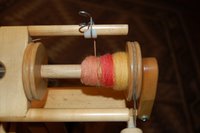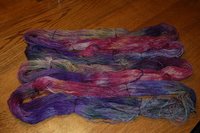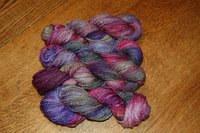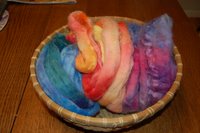
For the first time in a very long time, I got to stay home both days this weekend, and other than making some soap, nothing had to be done. I wanted to dye yarn but I had no real plans, other than create some fun hat yarn for two little girls. I backed both the cars out of the garage, rolled up my sleeves and got to work. Once all my soapmaking materials were ready to go, I measured the water, poured it into the glass jar that I have used for years, then poured in the lye. I do this on the floor of the garage so I can walk away from the fumes. Within seconds the steam began to rise, and I heard the distinctive pop of fatigued glass, followed by the trickle of lye water worming away from the jar. What a frightening mess. Long story short, I neutralized everything with vinegar, but after all the clean up, I still hadn’t started making soap. With nothing to mix the lye in, I went back to my Susan Cavitch book to find a substitute. It’s probably been eight years since I’ve looked at the instructions - very helpful and long overdue. I adjusted the temperature and stir time, and I came up with a much better batch.
 Thinking that it couldn’t hurt to look at the instructions on dying wool, I pulled out the Twisted Sisters book. The yarn I wanted to dye was off-white and probably wouldn’t produce the Easter egg colors I wanted, so I decided I’d dye roving for the girls instead. I used the hot pour method that
Thinking that it couldn’t hurt to look at the instructions on dying wool, I pulled out the Twisted Sisters book. The yarn I wanted to dye was off-white and probably wouldn’t produce the Easter egg colors I wanted, so I decided I’d dye roving for the girls instead. I used the hot pour method that 
The yarn and roving are all from Brown Sheep mill ends of wool and mohair that a friend picked up for me when she visited their operation in Nebraska.

For the roving I chose the cold pour method that
 This is the locks I dyed with my leftover cups of dye. I find it interesting that the yellow and red disappear in the blending.
This is the locks I dyed with my leftover cups of dye. I find it interesting that the yellow and red disappear in the blending.





















2 comments:
I think you made the best choice, and want a weekend retreat at home too, soon!
Beautiful pictures. Who needs SOAR to have fun!
Post a Comment